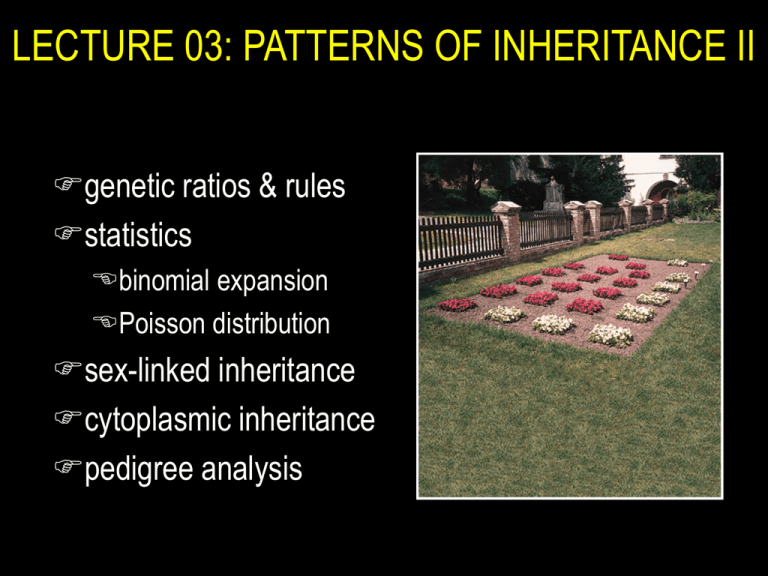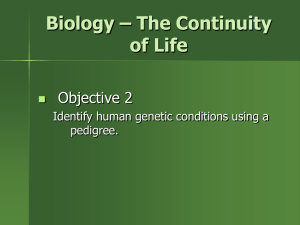GENETICS – BIO 300
advertisement

LECTURE 03: PATTERNS OF INHERITANCE II genetic ratios & rules statistics binomial expansion Poisson distribution sex-linked inheritance cytoplasmic inheritance pedigree analysis GENETIC RATIOS AND RULES product rule: the probability of independent events occurring together is the product of the probabilities of the individual events... AND A/a x A/a ½ A+ ½ a ½ A+ ½ a P(a/a) = ½ x ½ = ¼ sum rule: the probability of A/a x A/a either of two mutually ½ A+ ½ a ½ A+ ½ a exclusive events occurring is P(A/a) = ¼ + ¼ = ½ the sum of the probabilities of the individual events... OR STATISTICS: BINOMIAL EXPANSION diploid genetic data suited to analysis (2 alleles/gene) examples... coin flipping product and sum rules apply n use formula: (p+q)n = [n!/(n-k)!k!] (pn-kqk) = 1 k=0 define symbols... STATISTICS: BINOMIAL EXPANSION n use formula: (p+q)n = [n!/k!(n-k)!] (pkqn-k) = 1 k=0 define symbols... p = probability of 1 outcome, e.g., P(heads) q = probability of the other outcome, e.g., P(tails) n = number of samples, e.g. coin tosses k = number of heads n-k = number of tails = sum probabilities of combinations in all STATISTICS: BINOMIAL EXPANSION n use formula: (p+q)n = [n!/k!(n-k)!] (pkqn-k) = 1 k=0 e.g., outcomes from monohybrid cross... p = P(A_) = 3/4, q = P(aa) = 1/4 k = #A_, n-k = #aa 2 possible outcomes if n = 1: k = 1, n-k = 0 or k = 0, n-k = 1 3 possible outcomes if n = 2: k = 2, n-k = 0 or k = 1, n-k = 1 or k = 0, n-k = 2 4 possible outcomes if n = 3... etc. STATISTICS: BINOMIAL EXPANSION n use formula: (p+q)n = [n!/k!(n-k)!] (pkqn-k) = 1 k=0 e.g., outcomes from monohybrid cross... 1 offspring, n = 1, (p+q)1 = 1 2 offspring, n = 2, (p+q)2 = 1 3 offspring, n = 3, (p+q)3 = 1 (1!/1!0!)(¾)1(¼)0 = 3/4 (1!/0!1!)(¾)0(¼)1 = 1/4 = 1 (2!/2!0!)(¾)2(¼)0 = (1)9/16 (2!/1!1!)(¾)1(¼)1 = (2)3/16 (2!/0!2!)(¾)0(¼)2 = (1)1/16 = 1 16/16 (3!/3!0!)(¾)3(¼)0 = (1)27/64 (3!/2!1!)(¾)2(¼)1 = (3)9/64 P of 2A_ + 1aa (3!/1!2!)(¾)1(¼)2 = (3)3/64 (3!/0!3!)(¾)0(¼)3 = (1)1/16 = 1 STATISTICS: BINOMIAL EXPANSION Q: True breeding black and albino cats have a litter of all black kittens. If these kittens grow up and breed among themselves, what is the probability that at least two of three F2 kittens will be albino? A: First, define symbols and sort out basic genetics... one character – black > albino, one gene B > b ... STATISTICS: BINOMIAL EXPANSION P1: genotype: gametes: black BB P(B) = 1 × albino bb P(b) = 1 F1: genotype: gametes: black Bb P(B) = ½ , P(b) = ½ × black Bb P(B) = ½ , P(b) = ½ expected F 2: P(black) = P(B_) = (½ )2 + 2(½ )2 = ¾ = p P(albino) = P(bb) = (½ )2 = ¼ = q STATISTICS: BINOMIAL EXPANSION possible outcomes for three kittens... F2 * 3 black + 0 albino P ( ) = (¾ )3 × (¼ )0 = 27/64 P ( ) = (¾ )2 × (¼ )1 = 9/64 P ( ) = (¾ )2 × (¼ )1 = 9/64 P ( ) = (¾ )2 × (¼ )1 = 9/64 1 black + 2 albino P ( ) = (¾ )1 × (¼ )2 = 3/64 P ( ) = (¾ )1 × (¼ )2 = 3/64 P ( ) = (¾ )1 × (¼ )2 = 3/64 0 black + 3 albino P ( ) = (¾ )0 + (¼ )3 = 1/64 2 black + 1 albino Total Probability 64/64 STATISTICS: PASCAL’S TRIANGLE Sample Frequency Possible Outcomes* Combinations 1× 1+1 2 orders 2× 1+2+1 3 orders 3× 4 orders +++ 4× 1+4+6+4+1 5 orders 5× 1 + 5 + 10 + 10 + 5 + 1 6× 6 orders 1 + 6 + 15 + 20 + 15 + 6 + 1 7 orders STATISTICS: BINOMIAL EXPANSION n expansion of (p+q)n = [n!/k!(n-k)!] (pkqn-k) = 1 k=0 ... if p(black) = ¾, q(albino) = ¼, n = 3 ... expansion of (p+q)3 = (¾+¼)(¾+¼)(¾+¼ ) = (3!/3!0!) (¾)3(¼)0 = x 27/64 = 27/64 = P(0 albinos) (3!/2!1!) (¾)2(¼)1 = x 9/64 = 27/64 = P(1 albino) (3!/1!2!) (¾)1(¼)2 = x 3/64 = 9/64 = P(2 albinos) (3!/0!3!) (¾)0(¼)3 = x 1/64 = 1/64 = P(3 albinos) P(at least 2 albinos) = 9/64 + 1/64 = 5/32 } SEX-LINKED INHERITANCE SEX-LINKED INHERITANCE are homogametic are heterogametic SEX-LINKED INHERITANCE SEX-LINKED INHERITANCE SEX-LINKED INHERITANCE SEX-LINKED INHERITANCE all red all white SEX-LINKED INHERITANCE all red red and white the white gene is X-linked CYTOPLASMIC INHERITANCE selfing: are there differences between groups? are they true-breeding “genotypes”? CYTOPLASMIC INHERITANCE reciprocal crosses: are differences due to non-autosomal factors? compare progeny to see cytoplasmic influence STATISTICS: POISSON DISTRIBUTION binomial... sample size (n) 10 or 15 at most if n = 103 or even 106 need to use Poisson e.g. if 1 out of 1000 are albinos [P(albino) = 0.001], and 100 individuals are drawn at random, what are the probabilities that there will be 3 albinos ? formula: P(k) = e-np(np)k k! STATISTICS: POISSON DISTRIBUTION formula: P(k) = e-np(np)k k! k (the number of rare events) e = natural log = (1/1! + 1/2! + … 1/!) = 2.71828… n = 100 p = P(albino) = 0.001 np = P(albinos in population) = 0.1 P(3) = e–0.1(0.1)3/3! = 2.718–0.1(0.001)/6 = 1.5 × 10–4 PEDIGREE ANALYSIS pedigree analysis is the starting point for all subsequent studies of genetic conditions in families main method of genetic study in human lineages at least eight types of single-gene inheritance can be analyzed in human pedigrees goals identify mode of inheritance of phenotype identify or predict genotypes and phenotypes of all individuals in the pedigree ... in addition to what ever the question asks PEDIGREE ANALYSIS: SYMBOLS PEDIGREE ANALYSIS order of events for solving pedigrees 1. identify all individuals according number and letter 2. identify individuals according to phenotypes and genotypes where possible 3. for I generation, determine probability of genotypes 4. for I generation, determine probability of passing allele 5. for II generation, determine probability of inheriting allele 6. for II generation, same as 3 7. for II generation, same as 4… etc to finish pedigree PEDIGREE ANALYSIS additional rules... 1. unaffected individuals mating into a pedigree are assumed to not be carriers 2. always assume the most likely / simple explanation, unless you cannot solve the pedigree, then try the next most likely explanation PEDIGREE ANALYSIS Autosomal Recessive: Both sexes affected; unaffected parents can have affected progeny; two affected parents have only affected progeny; trait often skips generations. PEDIGREE ANALYSIS Autosomal Dominant: Both sexes affected; two unaffected parents cannot have affected progeny; trait does not skip generations. PEDIGREE ANALYSIS X-Linked Recessive: More affected than ; affected pass trait to all ; affected cannot pass trait to ; affected may be produced by normal carrier and normal . PEDIGREE ANALYSIS X-Linked Dominant: More affected than ; affected pass trait to all but not to ; unaffected parents cannot have affected progeny. PEDIGREE ANALYSIS Y-Linked: Affected pass trait to all ; not affected and not carriers. Sex-Limited: Traits found in or in only. Sex-Influenced, Dominant: More affected than ; all daughters of affected are affected; unaffected parents cannot have an affected . Sex-Influenced, Dominant: More affected than ; all sons of an affected are affected; unaffected parents cannot have an affected . PEDIGREE ANALYSIS mode of inheritance ? autosomal recessive autosomal dominant X-linked recessive X-linked dominant Y-linked sex limited I II III PEDIGREE ANALYSIS if X-linked recessive, what is the probability that III1 will be an affected ? I II III PEDIGREE ANALYSIS genotypes P(II1 is A/a) = 1 P(II2 is a/Y) = 1 A/Y a/a I II A/a a/Y III PEDIGREE ANALYSIS genotypes P(II1 is A/a) = 1 P(II2 is a/Y) = 1 gametes P(II1 passes A) = (1)(½) P(II1 passes a) = (1)(½) P(II2 passes a) = (1)(½) P(II2 passes Y) = (1)(½) A/Y a/a I II A/a a/Y III A a a/Y a Y PEDIGREE ANALYSIS A/Y genotypes I P(II1 is A/a) = 1 P(II2 is a/Y) = 1 gametes II P(II1 passes A) = (1)(½) A/a P(II1 passes a) = (1)(½) A a III P(II2 passes a) = (1)(½) a/Y P(II2 passes Y) = (1)(½) P(III1 is affected ) = (1)(½) (1)(½) = ¼ a/a a/Y a Y PATTERNS OF INHERITANCE: PROBLEMS in Griffiths chapter 2, beginning on page 62, you should be able to do ALL of the questions begin with the solved problems on page 59 if you are having difficulty check out the CD, especially the pedigree problems try Schaum’s Outline questions in chapter 2, beginning on page 66, and chapter 5, beginning on page 158







